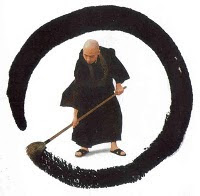Moksha (/moe-oak-shaw/, Sanskrit मोक्ष) or mokkha, vimutti, mukti [1] is a term in Buddhism, Yoga, Vedic Hinduism, Jainism, and Sikhism (the Dharmic religions) for various forms of liberation, emancipation, enlightenment, deliverance, and final release [2].
In its soteriological and eschatological senses, it refers to freedom from saṃsāra, the ongoing cycle of birth, death, rebirth, and redeath [3].
In its epistemological and psychological senses, moksha is freedom from ignorance: Know thyself, self-realization, self-actualization, and self-knowledge [4].
Moksha in its most basic definition is freedom from rebirths.
In Hindu traditions, moksha is a central concept [5] and the utmost aim to be attained through three paths during human life.
These three paths are dharma (virtuous, proper, moral life), artha (material prosperity, income security, means of life), and kama (pleasure, sensuality, emotional fulfillment) [6].
 |
| Moksha is liberated awakening in Yoga. |
However, terms such as moksha and nirvana differ and mean different states between various schools of Buddhism, Hinduism, and Jainism [9].
The term nirvana is more common in Buddhism [10], while moksha is more prevalent in Hinduism [11].
Etymology
Moksha is derived from the root, muc [12] (as in mukti), which means "free, let go, release, liberate." In the Vedas and early Upanishads, the word mucyate appears, which means "to be set free or release, such as of a horse from its harness."
Buddhism
In Buddhism the term moksha (Pali mokkha as in the patimokkha, the "path to moksha" or in Sanskrit pratimokṣa) is less common, with the equivalent term is vimutti, "freedom" or "release," being preferred.
In the sutras two forms of freedom are mentioned, namely ceto-vimutti, "deliverance of mind,” and paññā-vimutti, "deliverance through wisdom” (insight or vipassana).
Ceto-vimutti is related to the practice of jhana (dhyana), while panya-vimutti is related to the development of insight.
According to Gombrich, the distinction may be a later development that resulted in a change of doctrine, regarding the practice of jhana (serenity and samadhi) to be insufficient for final liberation [100].
With final release comes nirvana (Pali nibbana) “blowing out,” “quenching,” “cooling,” or “extinguishing” the fires of the passions and of ignorance and self-view in particular [101, 102].
It is a "timeless state” in which there is no more becoming [103]. Nirvana ends the cycle of pain-and-suffering (dukkha) and rebirth (patisandhi) in the 31 Planes of Existence, the wandering through which is called saṃsāra [104, Note 2].
It is one of the Four Noble Truths of Buddhist doctrine, which plays an essential role in Theravada Buddhism [109, 110].
Nirvana has been described in Buddhist texts, in a manner similar to other Indian religions, as the state of complete liberation, enlightenment, highest bliss, permanent happiness, fearlessness, freedom, dukkha-less, unchanging, absolute, non-dependently arising, unfathomable, imponderable, indescribable [111, 112].
 |
| What's the empty enso? Everything |
Such descriptions, states Peter Harvey, are contested by scholars because nirvana in Buddhism is ultimately described as a state of “stopped consciousness (blown out), but one that is not non-existent,” and “it seems impossible to imagine what awareness devoid of any object would be like” [116, 104].
But this seems the poverty of imagination of Western scholars who do not practice what they study and philosophize about. More
- What is the WAY to moksha? Pātimokkha





No comments:
Post a Comment